Wed Feb 27, 2008 12:07 am
Scott,
I have a few more Lowry pics of various aircraft. There is another photo of B-29's at Rapid City, SD with the circle R on the tail...and one at Lowry with an X on the tail...
Here ya go..
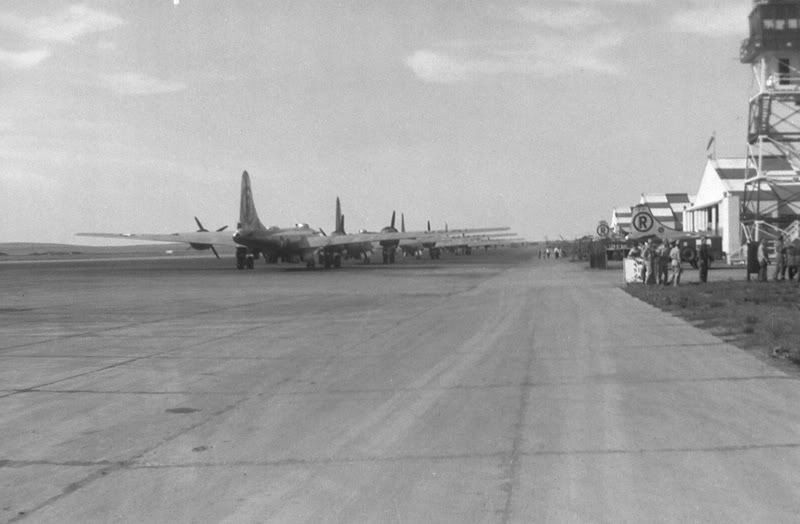
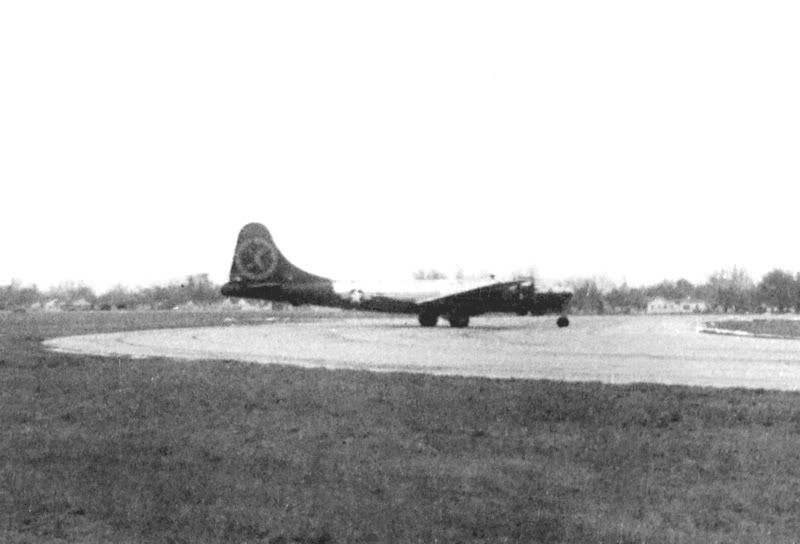
Zane
I have a few more Lowry pics of various aircraft. There is another photo of B-29's at Rapid City, SD with the circle R on the tail...and one at Lowry with an X on the tail...
Here ya go..


Zane
Wed Feb 27, 2008 1:45 am
Wow, I've never seen the coloring system on that last picture before. I wonder if the tail is arctic red with a yellow Circle X? I guess it could be all black that carried up from the belly paint with a red Circle X. And those Rapid City photos are great too! Notice that the airplane doesn't fit all the way in the hangar, those hangars were built for the B-17 and B-24 and couldn't accomodate the tail door needed for the Superfort. Great stuff, I thank all of you for sharing what you have.
Here is another Pyote photo that has been around for a while. The first airplane in the photo was a crew trainer most likely assigned to Chatham AAF in Savannah and the 324th Base Unit of the Combat Crew Training School, Third Air Force.

Scott
Here is another Pyote photo that has been around for a while. The first airplane in the photo was a crew trainer most likely assigned to Chatham AAF in Savannah and the 324th Base Unit of the Combat Crew Training School, Third Air Force.

Scott
Last edited by Second Air Force on Thu Jan 15, 2009 1:16 pm, edited 1 time in total.
Wed Feb 27, 2008 2:09 pm
Scott,
Yeah, I was wondering the same thing about the tail color on that airplane.
Glad I could share something of value to you.
Yeah, I was wondering the same thing about the tail color on that airplane.
Glad I could share something of value to you.
Wed Feb 27, 2008 2:24 pm
Zane,
As far as I'm concerned, any picture of any B-29 is of great value! Thanks for sharing them with everyone.
Thanks for sharing them with everyone.
Scott
As far as I'm concerned, any picture of any B-29 is of great value!
Scott
Fri Feb 29, 2008 2:23 am
Here are three more photos of airplanes that served in the training role:

The first is a mechanic's trainer from Amarillo, and I'd love to know how it got the name "Flying Solenoid"! I don't know the ultimate fate of this one, but suppose it was scrapped at the end of the war

This picture was taken on the apron at Walker Army Air Field in the winter of 43/44 when the 462nd Group was working up with the Superfortress. She was named "Ours" and went to the CBI with the Group, returning as a War Weary in January of '45. She was then a trainer stationed at Roswell and Pyote. This airplane was scrapped at Pyote in '49.

This color photo shows the jug logo with the "150" in it again like the photo of 42-6380 I posted earlier. This airplane was also scrapped at Pyote, and I assume the photo may have been taken there. Notice also the red vertical tail tip on the airplane in the background--several of these tail markings show up in other Pyote storage photos, but I am not sure what station used this device.
Scott

The first is a mechanic's trainer from Amarillo, and I'd love to know how it got the name "Flying Solenoid"! I don't know the ultimate fate of this one, but suppose it was scrapped at the end of the war

This picture was taken on the apron at Walker Army Air Field in the winter of 43/44 when the 462nd Group was working up with the Superfortress. She was named "Ours" and went to the CBI with the Group, returning as a War Weary in January of '45. She was then a trainer stationed at Roswell and Pyote. This airplane was scrapped at Pyote in '49.

This color photo shows the jug logo with the "150" in it again like the photo of 42-6380 I posted earlier. This airplane was also scrapped at Pyote, and I assume the photo may have been taken there. Notice also the red vertical tail tip on the airplane in the background--several of these tail markings show up in other Pyote storage photos, but I am not sure what station used this device.
Scott
Fri Feb 29, 2008 8:39 am
I always liked the OD ships
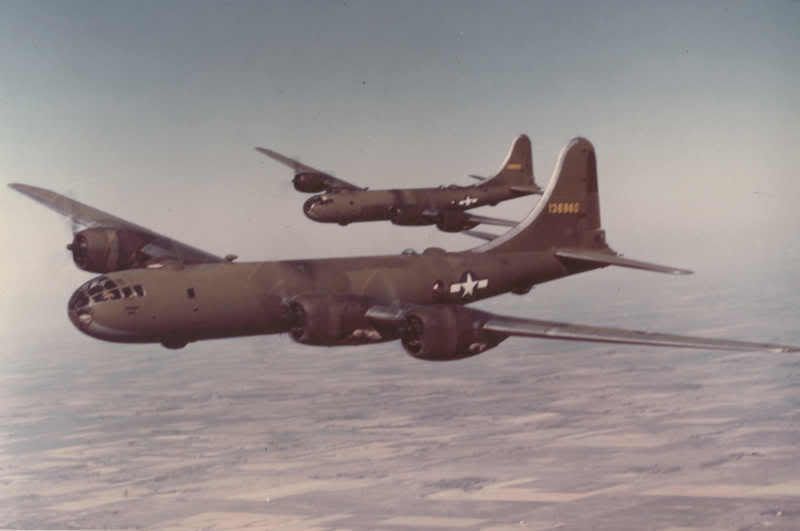
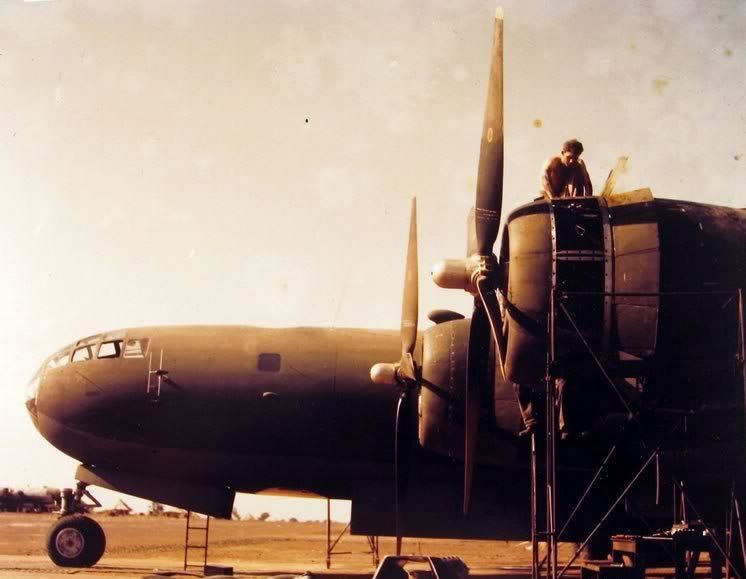
Martin


Martin
Fri Feb 29, 2008 12:05 pm
Martin,
I'm partial to the O.D. aircraft as well. I've been trying to find the exact number of camouflaged aircraft built without success. (yet). Do you have any idea where your last photo was taken? I'm going to guess that picture was snapped in India (early on) as the airplane still looks fairly clean and has been converted to a tanker judging by the missing turrets.
Your first photo shows two Pratt Army Air Field airplanes, the YB-29 in the foreground was the first Superfort assigned to the 40th Group for training. A mechanic acquaintence of mine recalled that when he first saw that airplane in the Sub-Depot hangar at Pratt it still had three-blade props. He also said that after they flew it for three or four hours the maintenance troops got to weld engine mount parts and exhaust components that had cracked. His experience with the early airplanes was that you flew for three hours and worked on them for three days (or more) and repeated the cycle.
Scott
I'm partial to the O.D. aircraft as well. I've been trying to find the exact number of camouflaged aircraft built without success. (yet). Do you have any idea where your last photo was taken? I'm going to guess that picture was snapped in India (early on) as the airplane still looks fairly clean and has been converted to a tanker judging by the missing turrets.
Your first photo shows two Pratt Army Air Field airplanes, the YB-29 in the foreground was the first Superfort assigned to the 40th Group for training. A mechanic acquaintence of mine recalled that when he first saw that airplane in the Sub-Depot hangar at Pratt it still had three-blade props. He also said that after they flew it for three or four hours the maintenance troops got to weld engine mount parts and exhaust components that had cracked. His experience with the early airplanes was that you flew for three hours and worked on them for three days (or more) and repeated the cycle.
Scott
Fri Feb 29, 2008 12:47 pm
I still can't get used to them in OD. 
Fri Feb 29, 2008 2:00 pm
You asked for it, Chad! 
Here is a mystery I have been trying to unravel for years. I was researching the "Fabulous Hudson Hornet" racing effort some time ago for a model display that we built for the Joe Weatherly Stock Car Museum at Darlington Raceway. I had two Hudsons to build, and it turned out that the first one was owned by Marshall Teague and driven to victory in 1951 by Herb Thomas. I was fortunate to meet Marshall's widow (he was the first man to lose his life at the new Daytona Speedway in 1959) and as we visited she mentioned that Marshall had been a flight engineer in the 462nd Bomb Group. She then opened a book that she had published in tribute to her late husband, and showed me this photo:

Marshall is the second man from the left in the bottom row with the dirty knee.
She then presented me with this ORIGINAL photo taken in the CBI of Marshall's airplane.

My mystery is this: Several of us have been working on the serial number for Old Man Mose for a while now. We think she was 42-6209, but the 462nd had several camouflaged aircraft. I desperately need the serial, squadron assignment, and a full picture of this old warrior for a project. Any help would be GREATLY appreciated.
Marshall did okay after getting out of the Air Corps--USAC stock car champion, Indianapolis Rookie of the Year in '53 (I think) and Daytona Beach winner in 1950.
Here is a mystery I have been trying to unravel for years. I was researching the "Fabulous Hudson Hornet" racing effort some time ago for a model display that we built for the Joe Weatherly Stock Car Museum at Darlington Raceway. I had two Hudsons to build, and it turned out that the first one was owned by Marshall Teague and driven to victory in 1951 by Herb Thomas. I was fortunate to meet Marshall's widow (he was the first man to lose his life at the new Daytona Speedway in 1959) and as we visited she mentioned that Marshall had been a flight engineer in the 462nd Bomb Group. She then opened a book that she had published in tribute to her late husband, and showed me this photo:

Marshall is the second man from the left in the bottom row with the dirty knee.
She then presented me with this ORIGINAL photo taken in the CBI of Marshall's airplane.

My mystery is this: Several of us have been working on the serial number for Old Man Mose for a while now. We think she was 42-6209, but the 462nd had several camouflaged aircraft. I desperately need the serial, squadron assignment, and a full picture of this old warrior for a project. Any help would be GREATLY appreciated.
Marshall did okay after getting out of the Air Corps--USAC stock car champion, Indianapolis Rookie of the Year in '53 (I think) and Daytona Beach winner in 1950.
Sun Mar 09, 2008 8:36 am
I stumbled upon a long-lost Boeing Magazine from July of '45 and thought this would be the perfect place to post a couple of images from it. Both pictures were taken at Alamogordo Army Air Field at the B-29 Combat Crew Training Center.

The data block on the aircraft shows that it is a TB-29-8?-BW, and the serial number appears to be 44-70121. The data block is extremely hard to read, and the dash number and serial may be in error, but it most definitely is a TB-29, a fairly rare designation that started to show up rather late in the war. In fact, FIFI was called a TB-29 for part of her service career.
This photo was taken on the apron at Alamogordo, and, of course, the primary activity is engine maintenance.

Scott

The data block on the aircraft shows that it is a TB-29-8?-BW, and the serial number appears to be 44-70121. The data block is extremely hard to read, and the dash number and serial may be in error, but it most definitely is a TB-29, a fairly rare designation that started to show up rather late in the war. In fact, FIFI was called a TB-29 for part of her service career.
This photo was taken on the apron at Alamogordo, and, of course, the primary activity is engine maintenance.

Scott
Mon Mar 10, 2008 1:20 pm
While talking about B-29s used in training, it is important to acknowledge that accidents occurred, both due to operational and maintenance issues. This first incident falls into the "lack of proper knowledge" column, and happened on the ramp at Harvard AAF. The rear bomb bay doors wouldn't close when preparing to taxi out for a mission (due to a bad motor, the investigation found) and a crew chief went to "help." A combination of errors caused the left gear to retract and this was the result:

This accident involved an O.D. airplane, and was published in a 2AF Accident Prevention magazine. The airplane had penetrated a bad thunderstorm complex according to the article, and this was the result. I don't have any other information about this photo except that it was weather related.

Scott

This accident involved an O.D. airplane, and was published in a 2AF Accident Prevention magazine. The airplane had penetrated a bad thunderstorm complex according to the article, and this was the result. I don't have any other information about this photo except that it was weather related.

Scott
Mon Mar 10, 2008 2:23 pm
My friend Dick Kamm maintained B-29s at Lowry in the mid 1950s. Here are some shots that he grabbed, I think, from one of them during training missions over Kansas.
I've left the last shot uncropped as, for me, even with the reflections and flare, it best conveys the feeling of what those trips must have been like.
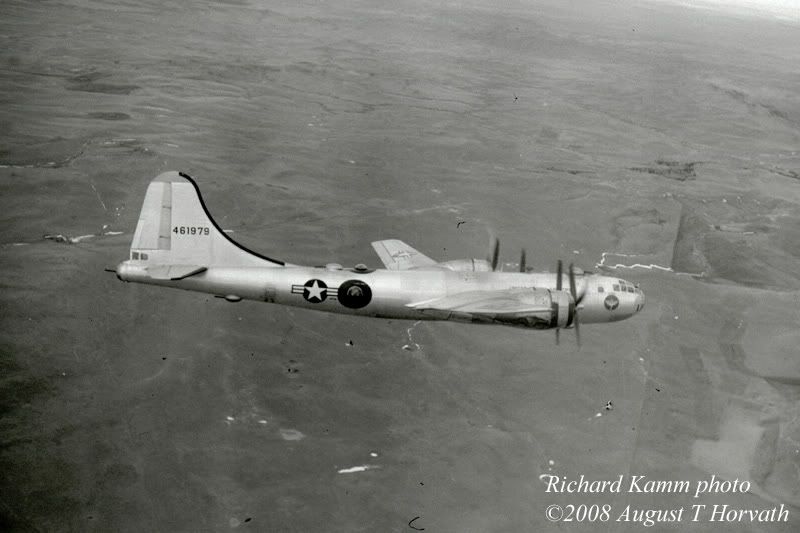
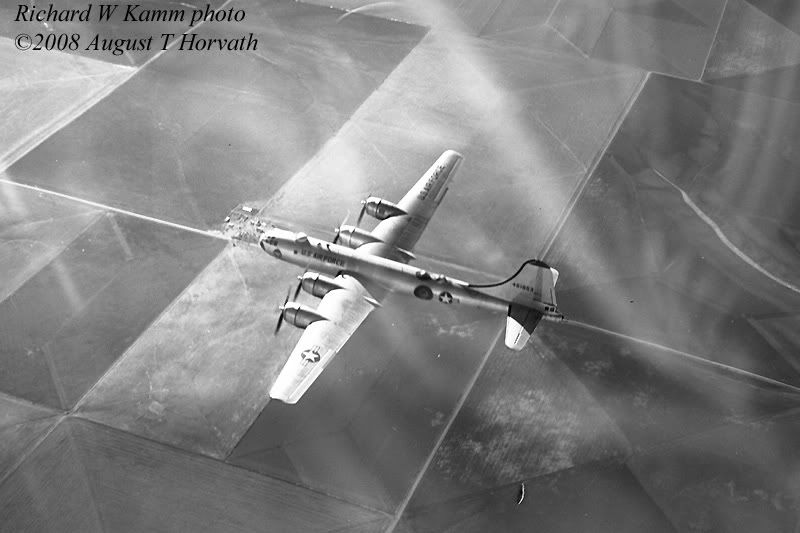

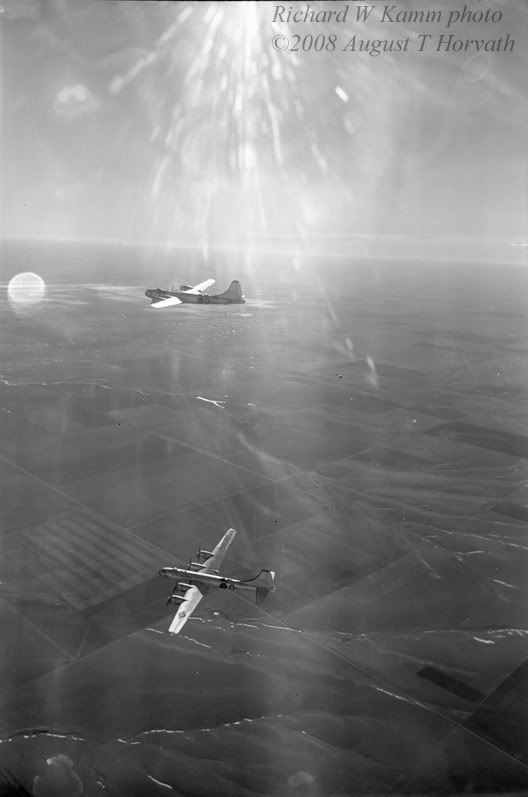
August
I've left the last shot uncropped as, for me, even with the reflections and flare, it best conveys the feeling of what those trips must have been like.




August
Mon Mar 10, 2008 2:31 pm
Richard!
WOW! Those are great photos.
Thanks so much for sharing.
WOW! Those are great photos.
Thanks so much for sharing.
Mon Mar 10, 2008 3:07 pm
I second the thanks, August!
I especially like the two shots with the sunlight working off the blister plexiglass, and I'm glad you left them as-is.
Notice that these airplanes have had the anti-glare paint applied around the sighting blisters. I don't know if there was a specific T.O. for this or if it was done by individual units or stations. It doesn't seem to have been a widespread practice, and it looks kind of odd if you ask me.
Keep the great photos coming, everyone!
Scott
I especially like the two shots with the sunlight working off the blister plexiglass, and I'm glad you left them as-is.
Notice that these airplanes have had the anti-glare paint applied around the sighting blisters. I don't know if there was a specific T.O. for this or if it was done by individual units or stations. It doesn't seem to have been a widespread practice, and it looks kind of odd if you ask me.
Keep the great photos coming, everyone!
Scott
Sat Mar 15, 2008 10:05 pm
This is the last photo I was able to image at Pyote when I was out there. The airplane was the last B-29-1-BA built, and this was very likely the last time the airplane ever flew. There are a couple of noteworthy things about this picture--the 20mm still appears to be installed, and there is certainly ample rudder trim rolled in!

The handwritten inscription in the bottom right corner reads:
Pyote A.A.F.
9-14-45
Pilot-Capt. J.G. Jordan
Airplane Commmander-Capt. Payne
Engines 1&2 Feathered on B-29 at 8000 ft.
Ind-190 M.P.H.
Descending 150'/min
2000 RPM
30" Mercury
I've got plenty of time to start my book research again, so when we get back from Maxwell I'll share some more training stuff.
Scott

The handwritten inscription in the bottom right corner reads:
Pyote A.A.F.
9-14-45
Pilot-Capt. J.G. Jordan
Airplane Commmander-Capt. Payne
Engines 1&2 Feathered on B-29 at 8000 ft.
Ind-190 M.P.H.
Descending 150'/min
2000 RPM
30" Mercury
I've got plenty of time to start my book research again, so when we get back from Maxwell I'll share some more training stuff.
Scott